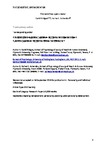The sensitive, open creator
| dc.contributor.author | Bridges, D | en |
| dc.contributor.author | Schendan, H | en |
| dc.date.accessioned | 2018-09-20T18:52:31Z | |
| dc.date.issued | 2019-05-01 | en |
| dc.identifier.issn | 0191-8869 | en |
| dc.identifier.uri | http://hdl.handle.net/10026.1/12403 | |
| dc.description.abstract |
Identifying a creative personality has been challenging. Sensitivity was implicated in creativity in early studies but more recently defined as a biologically-based personality dimension (i.e., temperament). In this paper we aim to establish relationships between temperament, personality and creative potential and achievement. This laboratory study with a large diverse sample used multiple recently established sensitivity and creativity measures while controlling negative-affect and Big-Five personality traits. Only sensitivity and openness correlate positively with three creativity measures and independently predict two (achievement, ideation). Openness predicts creative products and achievement more strongly as sensitivity rises above average, and conversely. Sensitivity and openness primarily determine diverse creative abilities and demonstrate vantage-sensitivity. Developmental environment interacting with neurosensitivity mechanisms (especially lower inhibition), and automatic attention may explain why sensitive, open people are more creative. | en |
| dc.format.extent | 179 - 185 | en |
| dc.language.iso | en | en |
| dc.publisher | Elsevier | en |
| dc.rights | Attribution-NonCommercial-NoDerivatives 4.0 International | en |
| dc.rights | Attribution-NonCommercial-NoDerivatives 4.0 International | en |
| dc.rights | Attribution-NonCommercial-NoDerivatives 4.0 International | en |
| dc.rights | Attribution-NonCommercial-NoDerivatives 4.0 International | en |
| dc.rights.uri | http://creativecommons.org/licenses/by-nc-nd/4.0/ | en |
| dc.rights.uri | http://creativecommons.org/licenses/by-nc-nd/4.0/ | en |
| dc.rights.uri | http://creativecommons.org/licenses/by-nc-nd/4.0/ | en |
| dc.rights.uri | http://creativecommons.org/licenses/by-nc-nd/4.0/ | en |
| dc.subject | creativity | en |
| dc.subject | temperament | en |
| dc.subject | personality | en |
| dc.subject | plasticity | en |
| dc.subject | adult personality development | en |
| dc.title | The sensitive, open creator | en |
| dc.type | Journal Article | |
| plymouth.volume | 142 | en |
| plymouth.journal | Personality and Individual Differences | en |
| dc.identifier.doi | 10.1016/j.paid.2018.09.016 | en |
| plymouth.organisational-group | /Plymouth | |
| plymouth.organisational-group | /Plymouth/REF 2021 Researchers by UoA | |
| plymouth.organisational-group | /Plymouth/REF 2021 Researchers by UoA/UoA04 Psychology, Psychiatry and Neuroscience | |
| plymouth.organisational-group | /Plymouth/Research Groups | |
| plymouth.organisational-group | /Plymouth/Research Groups/Centre for Brain, Cognition and Behaviour (CBCB) | |
| plymouth.organisational-group | /Plymouth/Research Groups/Centre for Brain, Cognition and Behaviour (CBCB)/Brain | |
| dcterms.dateAccepted | 2018-09-14 | en |
| dc.rights.embargodate | 2020-09-19 | en |
| dc.rights.embargoperiod | Not known | en |
| rioxxterms.version | AM | en |
| rioxxterms.versionofrecord | 10.1016/j.paid.2018.09.016 | en |
| rioxxterms.licenseref.uri | http://creativecommons.org/licenses/by-nc-nd/4.0/ | en |
| rioxxterms.licenseref.startdate | 2019-05-01 | en |
| rioxxterms.type | Journal Article/Review | en |
| plymouth.funder | CogNovo: Cognitive Innovation::Research Executive Agency European Union FP7 | en |
| plymouth.funder | CogNovo: Cognitive Innovation::Research Executive Agency European Union FP7 | en |



